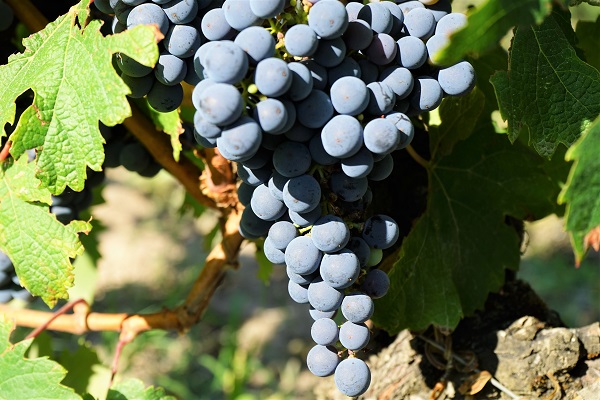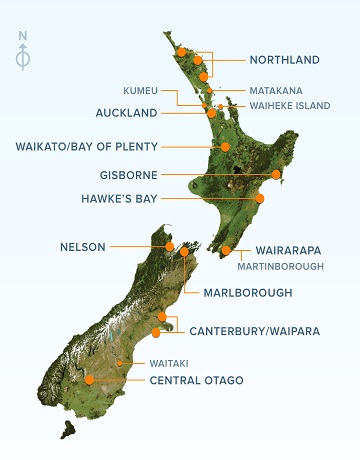Cabernet Sauvignon
Regions

Cabernet Sauvignon is the world's most planted red wine grape.
Cabernet Sauvignon in France
The French Cabernet Sauvignon blend is the most copied wine style in the world. The Cabernet Sauvignon grape is the king of the Left Bank of the Garonne river in Bordeaux.
Most famous appelations:
Mèdoc AOC and Haut Mèdoc AOC
Subregions: Saint Estèphe AOC, Pauillac AOC, Saint Julien AOC, Margaux AOC
Graves AOC
Subregion: Pessac-Leognan AOC
Cabernet Sauvignon in USA
USA is the largest wine market in the world, and blended Cabernet Sauvignon is the number one selling wine.
Best known areas/regions:
Napa Valey (California)
Sonoma (California)
Wahington State
USA is the largest wine market in the world, and blended Cabernet Sauvignon is the number one selling wine. The best known regions are California (Napa, Sonoma) and Washington State.
The father of California wine is franciscan missionary Father Junípero Serra, he is the man behind the first vineyard (San Diego 1769) planted with a variety called Mission Grape, for making sacramental wines. Cabernet Sauvignon grape arrives later, around 1852.
Napa Valley Cabernet Sauvignon becomes worldwide famous at the Judgement of Paris in 1976 when Stag´s Leap Winery wins the first price ahead of the best French Châteaux.

Cabernet Sauvignon in New Zealand
New Zealand Cabernet Sauvignon is often blended with Merlot to produce an easy style Cab, ready to drink in 3 to 5 years. Dark fruits, cassis, raspberry and forest floor are typical aromas.
Best known area/region:
Hawke's Bay
New Zealand Cabernet Sauvignon is often blended with Merlot to produce an easy style Cab, ready to drink in 3 to 5 years. Dark fruits, cassis, raspberry and forest floor are typical aromas.
Already in mid-1800s both Cabernet Sauvignon and Merlot were cultivated in New Zealand.
The best production areas are the warmer ones: Hawke´s Bay, Auckland and Northland.
Soils: great diversity including volcanic, alluvial, gravel and clay.
Cabernet Sauvignon in Australia
In Australia, the most blended grapes are Shiraz and Cabernet Sauvignon.
Australia used to make heavy, oaky and powerful Cabernet Sauvignon blends, but the trend is rapidly changing and the new versions are less oaked, and better balanced, meeting the approval of a larger market.
The new Australian trend is less oak and better balance (approved by a larger market). In Australia Cabernet Sauvignon is often blended with Shiraz which adds peppery aromas.
The wine pioneer James Busby brought the first rootstock from France in 1832 but the vines died, due to lack of expertise. The key was to find the appropriate terroir.
Today is Cabernet Sauvignon Australia´s third most planted grape, after Shiraz and Chardonnay.
Best known areas/regions:
Margaret River
Coonavarra

Thanks to the variety of climates, you can have a cold clima Cabernet tasting more "green": capsicum, tomato leaf, bell pepper, herbaceous or a warm clima Cabernet tasting jammy, cooked black fruit.
Cool climate regions in this hot continenet seem to performe best (Coonawarra, Margaret River).
Cabernet Sauvignon in South Africa
South African Cabernet Sauvignon is more Bordeaux style than California style, with cassis, violets, and
cedar wood aromas. South African Cabernet often delivers a good value for your money.
Cape Blend is a name used when Cabernet Sauvignon and/or Merlot is blended with the local grape Pinotage.
Best known area/region:
Stellenbosch
South African Cabernet Sauvignon is more Bordeaux than California style, with cassis, violets, and cedar wood aromas. The good balance and affordable prices make it a winner.
Winemaking in South Africa started around 1650 pushed by the arrival of the Dutch East India Company and the king of grapes Cabernet Sauvignon has found an ideal terroir, especially in Stellenbosch near Cape Town.
Stellenbosch is known as "the town of oaks" and , thanks to its educational and research center, it has become South Africa wine capital. The surrounding granite mountains, the windy maritime climate, the diversity of terroirs, good rainfall and deep well_drained soils benefit its wines.
Cabernet Sauvignon in Chile
Chilean Cabernet Sauvignon is often an easy drinking wine with soft tannins and aromas of mint, black currant, olives and smoke. Chilean Cabernet Sauvignon is a best value wine: a lot of quality for the money!
Best known areas/regions:
Cenral Valley with the subregions: Maipo Valley and Colchauga Valley
Chilean Cabernet Sauvignon style is often an easy drinking wine with soft tannins and aromas of mint, black currant, olives and smoke.
Chilean Cabernet Sauvignon is a best value wine: a lot of quality for the money!
With the Andes to the east, the Pacific to the west and a long coastline, here you can find a broad selection of climates: hot and dry near the Equator, to cool and wet near the South Pole.
Spanish conquistadors and missionaries brought vines to Chile in 1554. Today Cabernet Sauvignon is the king grape with 41.000 planted hectares. Chile is second only to France.

Cabernet Sauvignon in Italy
Cabernet Sauvignon is particularly famous in Tuscany where it is blended with Sangiovese and Merlot to create the famous Supertuscan wines.
Tuscany is the italian version of Bordeaux wine region in France. Cabernet Sauvignon in Tuscany is cultivated both in Chianti, in the hills of Castagneto Carduccci and in Maremma (DOC Bolgheri).
During the 70ies in Tuscany was created a new blend called Super Tuscan. A mix of local grape Sangiovese and Bordeaux Style grapes (Cabernet Sauvignon, Cabernet Franc, Merlot).
Best Regions:
- Trentino-Alto Adige (Bolzano)
- Veneto (Colli Euganei)
- Friuli-Venezia-Giulia (Collio)
Cabernet Sauvignon in Spain
The increasing demand has pushed Spain to plant this grape varietal in different regions such Catalonia, Navarra and La Mancha. In Spain Cabernet Sauvignon grapes are blended with Tempranillo, Garnacha and Monastrell.
Cabernet Sauvignon in Argentina
The hot and dry mountain climate facilitates the ripening of Cabernet Sauvignon grapes. Here the Cabs are very similar to the Malbecs: full bodied and with an excellent price/quality ratio. High altitude and cold climate Cabs tend to express spicy, menthol and herbal aromas.
The hot and dry mountain climate of Argentina facilitates the ripening of Cabernet Sauvignon grapes. Here the Cabs are very similar to the Malbecs: full bodied and with an excellent price/quality ratio. High altitude and cold climate Cabs tend to express spicy, menthol and herbal aromas.
Cabernet Sauvignon grapes in Bordeaux (France) and Napa Valley (USA), the two most famous producing regions, grow close to oceans and rivers. Water there is an important factor.
Mendoza in Argentina, has almost 80% of the grape production and an arid mountain terroir with vineyards at 700m to 950m.
Cabernet Sauvignon in China
China is the world´s largest red wine consumer country and, to meet the market, Cabernet Sauvignon is the most planted grape there too.


